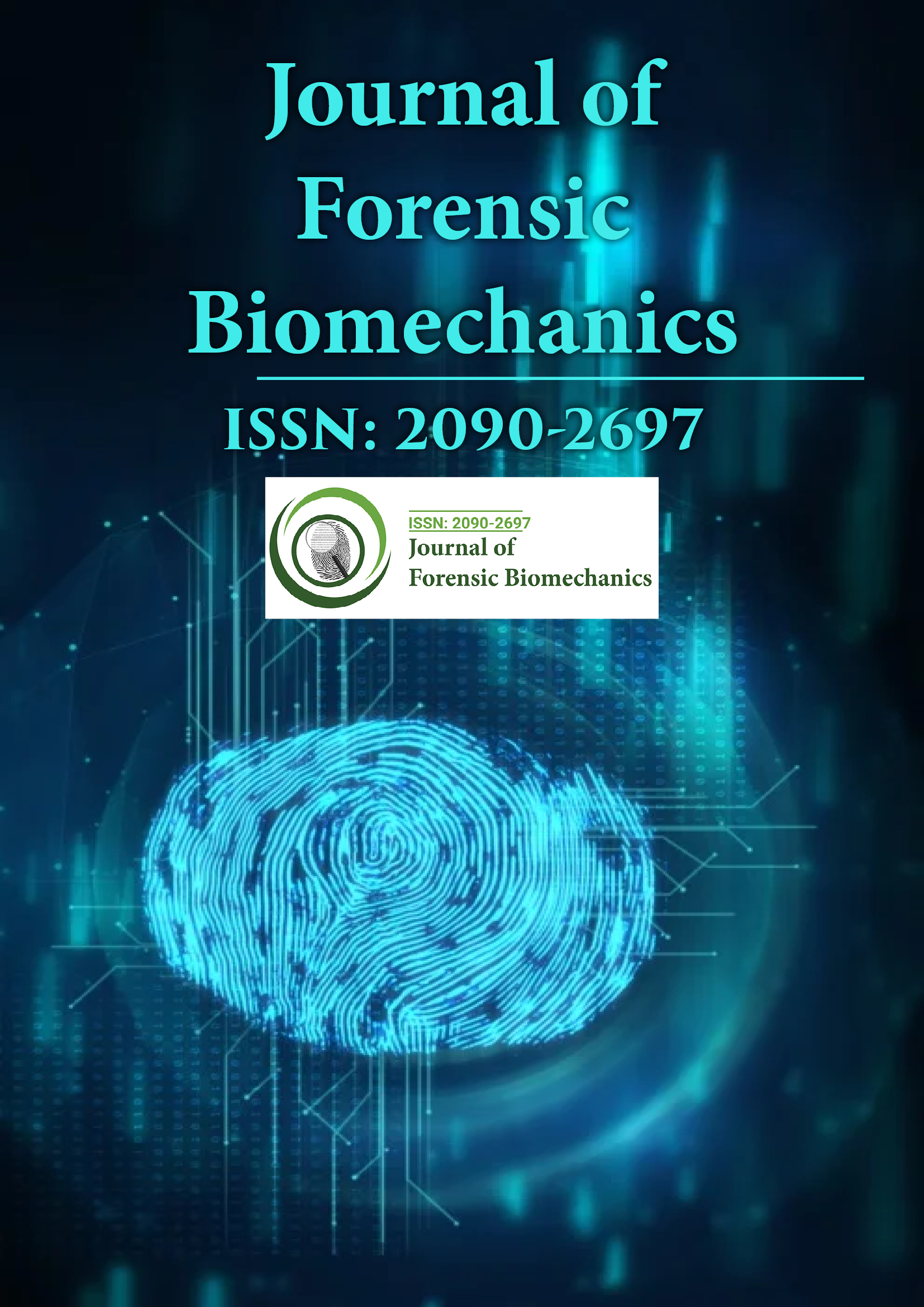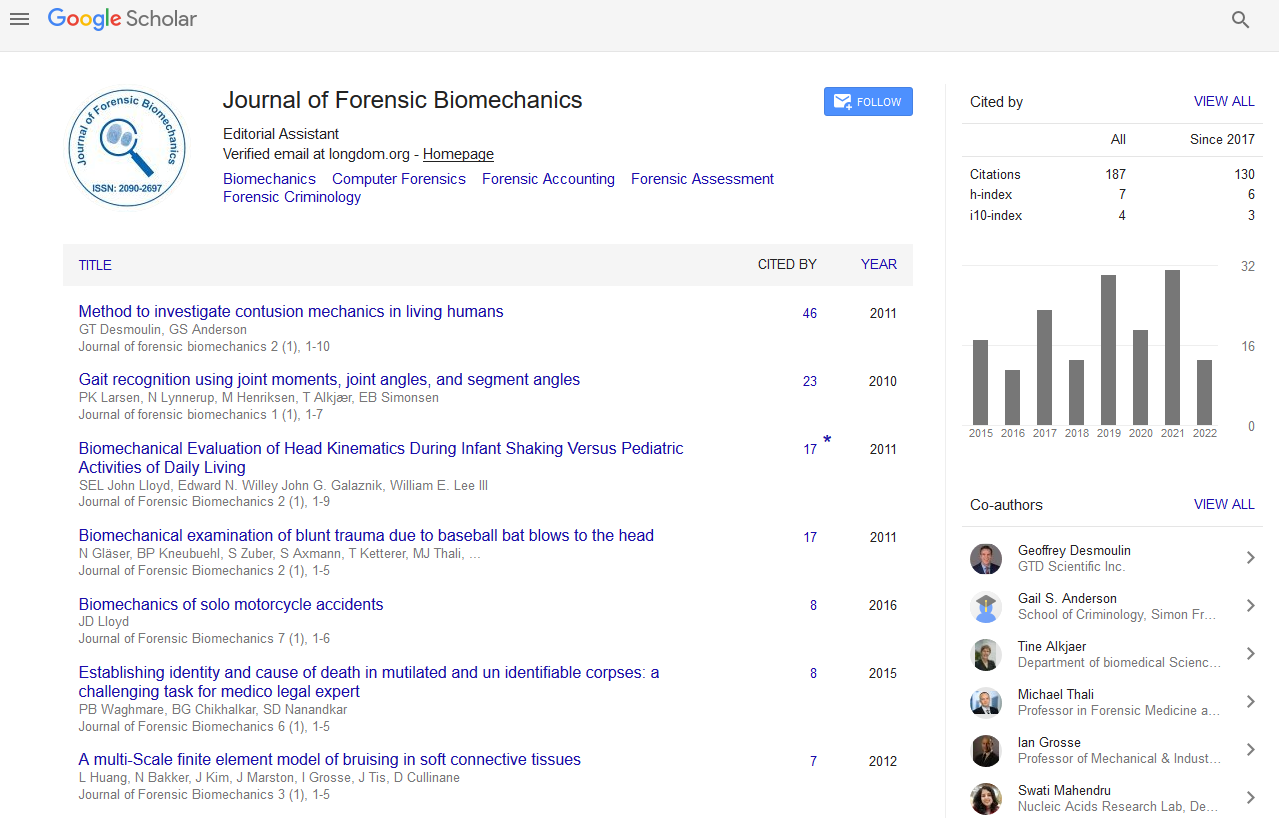Indexed In
- Genamics JournalSeek
- SafetyLit
- Ulrich's Periodicals Directory
- RefSeek
- Hamdard University
- EBSCO A-Z
- Geneva Foundation for Medical Education and Research
- Euro Pub
- Google Scholar
Useful Links
Share This Page
Journal Flyer

Open Access Journals
- Agri and Aquaculture
- Biochemistry
- Bioinformatics & Systems Biology
- Business & Management
- Chemistry
- Clinical Sciences
- Engineering
- Food & Nutrition
- General Science
- Genetics & Molecular Biology
- Immunology & Microbiology
- Medical Sciences
- Neuroscience & Psychology
- Nursing & Health Care
- Pharmaceutical Sciences
Commentary - (2025) Volume 16, Issue 1
Through Force Trauma Investigations: A Biomechanical Perspective
William Rosy*Received: 01-Jan-2025, Manuscript No. JFB-25-28533; Editor assigned: 03-Jan-2025, Pre QC No. JFB-25-28533 (PQ); Reviewed: 17-Jan-2025, QC No. JFB-25-28533; Revised: 24-Jan-2025, Manuscript No. JFB-25-28533 (R); Published: 31-Jan-2025, DOI: 10.35248/2090-2697.25.16.513
Description
Through force strain is one of the most common types of injuries encountered in forensic investigations. It occurs when a non-sharp object impacts the body, causing injuries that range from minor bruises to severe fractures and internal organ damage. Understanding the biomechanics of direct force trauma is crucial for reconstructing crime scenes, determining the cause and mechanism of injury distinguishing between accidental and intentional harm. Forensic biomechanists analyze the forces involved, the nature of the impact the resulting injuries to provide critical insights in criminal and civil cases. The biomechanics of direct force trauma involve the interaction between an external force and the body's tissues. When a force is applied, the body absorbs the impact, leading to deformation of soft tissues, bones organs. The severity of the injury depends on multiple factors, including the magnitude and direction of the force, the area over which it is applied, the duration of impact the properties of the affected body part. A concentrated force over a small area, such as a blow from a baseball bat, is more likely to cause deep tissue damage or fractures compared to a broader impact, such as a fall onto a flat surface. One of the key aspects of forensic biomechanics is analyzing injury patterns to determine the nature of the impact.
Different types of direct force trauma result in characteristic injuries. Contusions, or bruises, occur when blood vessels beneath the skin rupture due to compression forces. The color and spread of bruising help estimate the age of the injury and the direction of force. Lacerations, which are tears in the skin and soft tissues, often occur due to the stretching and crushing effects of direct impact. Unlike incised wounds caused by sharp objects, lacerations exhibit irregular edges and tissue bridging. Abrasions, or scrapes, result from frictional forces, commonly seen in dragging injuries. Fractures are another critical indicator in direct force trauma investigations. The location and pattern of bone fractures provide valuable forensic information. For example, in motor vehicle accidents, femur fractures are common due to direct impact against the dashboard, while skull fractures may indicate high-velocity head trauma. The biomechanics of bone failure depend on the type of force applied. Compression forces cause crush fractures, bending forces lead to transverse fractures twisting motions result in spiral fractures. Rib fractures are often analyzed in cases of suspected child abuse, as they may indicate excessive force applied during shaking or squeezing.
Forensic experts also analyze weapon-related direct force injuries. The shape and mass of an object influence the injury pattern. A cylindrical object like a metal rod creates linear bruising and deep tissue damage, whereas a flat object like a plank distributes force over a wider area, causing more diffuse trauma. The presence of patterned injuries, such as those matching a specific weapon or object, can be crucial in linking a suspect to a crime. In some cases, forensic scientists conduct controlled impact tests with similar objects to compare injury characteristics. As technology advances, forensic biomechanics will continue to play a vital role in understanding direct force trauma. The integration of artificial intelligence, improved imaging techniques real-time motion analysis will enhance injury reconstructions, providing more reliable evidence in forensic investigations. By applying the principles of biomechanics, forensic scientists can uncover the truth behind injuries, helping to solve crimes, exonerate the innocent ensure justice is served.
Citation: Rosy W (2025). Through Force Trauma Investigations: A Biomechanical Perspective. J Forensic Biomech. 16:513.
Copyright: © 2025 Rosy W. This is an open-access article distributed under the terms of the Creative Commons Attribution License, which permits unrestricted use, distribution reproduction in any medium, provided the original author and source are credited.

